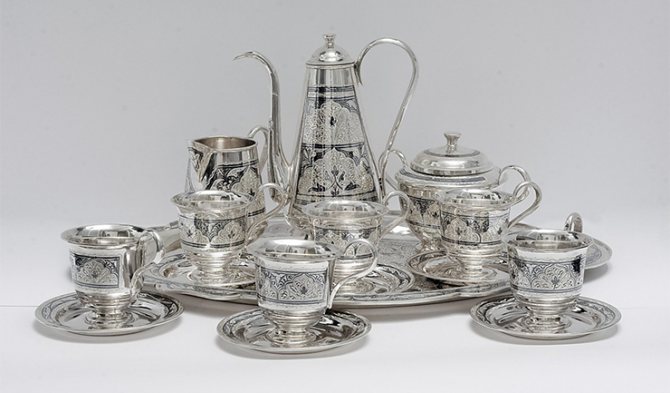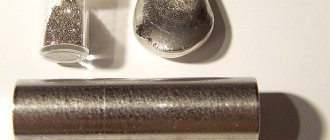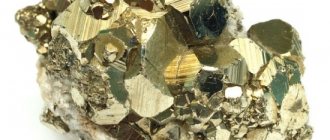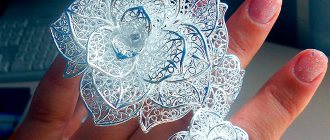Silver in nature
Silver is a fairly rare element, containing only about 0.000001% in the lithosphere. This is about a thousand times less than the copper content in the earth's crust. Despite its rarity, silver is more often found in the form of nuggets, which is why it has been known since time immemorial. Nowadays, native silver has become rare; the bulk of silver is found in a variety of minerals, the main of which is argentite Ag2S. Also, most of it is found in the so-called polymetallic ores, in which silver is adjacent to metals such as lead, zinc and copper.
History of the discovery of Silver Argentum
The discovery of the element Argentum - silver has been known to mankind since ancient times. This is due to the fact that at one time silver, as well as gold, was often found in its native form - it did not have to be smelted from ores. This predetermined the rather significant role of silver in the cultural traditions of various peoples. One of the oldest centers for the mining and processing of silver was prehistoric Sardinia, where it was known since the early Chalcolithic.
In Assyria and Babylon, silver was considered a sacred metal and was a symbol of the Moon. In the Middle Ages, silver and its compounds were very popular among alchemists. Since the middle of the 13th century, silver has become a traditional material for making tableware. In addition, silver is still used to this day for minting commemorative coins (the withdrawal of the last silver coins from circulation in the 1960s and 1970s approximately coincided with the crisis of the Bretton Woods monetary system).
origin of name
Slavic names of metal - Russian. silver, Polish srebro, Bulgarian silver, ancient glory silver - goes back to the Proto-Slavic *sеrebro
, which has correspondences in the Baltic (Lit. sidabras, Old Prussian
sirablan
) and Germanic (Gothic silubr, German Silber, English silver) languages.
Further etymology outside the German-Balto-Slavic circle of languages is unclear, suggesting either a derivation from the same base as Anatolian subau-ro
“brilliant”, or an early borrowing from the languages of the Middle East: cf. Akkadian sarpu "refined silver", from Akkad. sarapu “to purify, to melt,” or from the pre-Indo-European languages of ancient Europe: cf. Basque. zilar.
The Greek name for silver is ἄργυρος, árgyros
comes from the Indo-European root
*H₂erǵó-, *H₂erǵí-
, meaning “white, shining.”
argentum,
comes from the same root .
Historical facts about silver
There is a legend that the first silver mines were discovered in 968 by none other than the founder of the Holy Roman Empire, the East Frankish king Otto I the Great. Legend has it that one day the king sent his huntsman into the forest to hunt. During the hunt, he tied the horse to a tree, which, while waiting for the owner, dug up the ground with its hooves, where there were unusual light stones. The emperor realized that this was silver and ordered a mine to be founded at this place. There is evidence that this rich mine was developed six centuries later. This is evidenced by the records of the German physician and metallurgist Georg Agricola (1494–1555). In general, Central Europe was very rich in deposits of silver nuggets. In Saxony in 1477, one of the largest nuggets in history was found weighing up to 20 tons! Millions of European coins were minted from silver mined in the Czech Republic, near the city of Joachimsthal. That’s why they were called “Joachimsthaler”; Over time, the word was shortened to "thaler". In Russia, this name was changed in its own way and here they were called “efimkas”. Silver thalers were the most common European coin in history, hence the modern name "dollar".
Czech Bohemian Joachimsthaler
European silver mines were so rich that silver consumption was measured in tons! But because The bulk of European silver mines were discovered in the 14th-16th centuries, but by now they have already been depleted. After the discovery of America, it turned out that this continent is very rich in silver. Its deposits have been discovered in Chile, Peru and Mexico. Argentina was even named after the Latin name for silver. Here we need to point out a very interesting fact. Geographical names of chemical elements were usually given to an element from the name of a place, for example, hafnium is named after the Latin name of the city of Copenhagen in which it was discovered, the elements polonium, ruthenium, gallium and others have geographical names. Just the opposite happened. The country was named after a chemical element! This is the only such case in history. Silver nuggets are still found in America today. One of them was discovered already in the 20th century in Canada. This nugget was 30 meters long and 18 meters deep! After mastering this nugget, it turned out that it contained 20 tons of pure silver!
What is Silver, argentum, characteristics, properties
Silver is a chemical element
(
Ag from the Latin Argentum) - an element of group 11 (according to the outdated classification - a secondary subgroup of the first group), the fifth period of the periodic system of chemical elements of D.I. Mendeleev, with atomic number 47.
The simple substance silver is malleable, ductile noble metal of silver-white color. The crystal lattice is face-centered cubic. Melting point - 962 °C, density - 10.5 g/cm³.
Chemical properties of silver
Silver is a relatively soft and ductile metal; from 1 g of it you can draw a metal thread 2 km long! Silver is a heavy metal and has low thermal and electrical conductivity. The melting point is relatively low, only 962° C. Silver readily forms alloys with other metals, which give it new properties, for example, by adding copper, a harder alloy is obtained - billon. Under normal conditions, silver is not subject to oxidation, but has the ability to absorb oxygen. When heated, solid silver can dissolve five times the volume of oxygen! An even larger volume of gas is dissolved in liquid silver, approximately 20:1. Iodine can attack silver. The noble metal is especially “afraid” of iodine tincture and hydrogen sulfide. This is the reason why silver darkens over time. Sources of hydrogen sulfide in everyday life include spoiled eggs, rubber, and some polymers. When hydrogen sulfide and silver react, especially at high humidity, a very strong sulfide film is formed on the metal surface, which is not destroyed by heating and exposure to acids and alkalis. It can only be removed mechanically, for example with a brush with toothpaste applied to it. The biochemical properties of silver are interesting. Despite the fact that silver is not a bioelement, it can influence the vital activity of microbes by suppressing the work of their enzymes. This occurs when silver combines with an amino acid that is part of the enzyme. Therefore, water in silver vessels does not spoil, because it inhibits the activity of bacteria.
Interesting Facts
What remains unique is the fact that silver is never found in places where gold is mined. Just like gold cannot be found in silver deposits. This fact still causes surprise, but scientists have not found an explanation for it. In addition, two other points characteristic of silver also attract attention:
- Negative effects on the body. Despite the many healing properties attributed to silver since ancient times, its concentration in too large quantities can have a detrimental effect on the human body. Through various experiments, scientists have proven that exceeding the maximum permissible amount of silver ions can reduce the immunity of living organisms, change the normal natural course and functioning of the nervous and cardiovascular systems. Silver has the greatest negative impact on the functioning of the liver, kidneys and thyroid gland. Interesting! There are frequent cases of people being poisoned with drugs that contain silver. The main signs of intoxication are unexpected mental disorders. The attacks were stopped thanks to the easy removal of silver from the body.
- Darkening of silver items. Silver jewelry sold in jewelry stores contains copper in the alloys from which they are made. Humid air, sweat, water and other structures cause copper oxidation processes. This is manifested in the darkening of the silver product due to the silver sulfide formed on its surface, which becomes thicker if timely measures are not taken to remove it.
In addition to external factors, the darkening of silver can be caused by internal changes in the body. This affects those who are used to wearing silver every day to a greater extent.
In addition to the fact that silver continues to be at the peak of fashion among jewelry, and is also used in various areas of human activity, it is also a good way to invest. The combination of these properties determines the value of the noble metal in the modern world.
You may be interested in: How to determine the authenticity of silver at home?
Application of silver
Since ancient times, silver has been used in the manufacture of mirrors; nowadays it is being replaced with aluminum to reduce the cost of production. The low electrical resistance of silver is used in electrical engineering and electronics, where various contacts and connectors are made from it. Currently, silver is practically not used for the production of coins; only commemorative coins are made from it. Most of the silver is used in jewelry and cutlery. Silver is also widely used in the chemical and food industries. The use of silver iodide is interesting. With its help you can control the weather. By spraying tiny amounts of silver iodide from an airplane, they achieve the formation of water droplets, i.e. in other words, it causes rain. If necessary, you can perform the opposite task when rain is completely unnecessary, for example, during some very important event. To do this, silver iodide is sprayed tens of kilometers away from the event site, then rain will fall there, and dry weather will occur in the desired place. Silver is widely used in medicine. It is used as dentures, in the production of medicines (collargol, protargol, lapis, etc.) and medical instruments.

Silver table service
Physical properties
Silver nugget
Pure silver is a rather heavy (lighter than lead, but heavier than copper, density - 10.5 g/cm³), unusually ductile silver-white metal (light reflection coefficient is close to 100%). Thin silver foil appears violet in transmitted light. Over time, the metal tarnishes, reacting with traces of hydrogen sulfide in the air and forming a sulfide coating, whose thin film then gives the metal a characteristic pinkish color. It has the highest thermal conductivity among metals. At room temperature it has the highest electrical conductivity among all known metals (electrical resistivity 1.59⋅10−8 Ohm m at a temperature of 20 °C). A relatively refractory metal, melting point 962 °C.
The effect of silver on humans
As we saw above, the use of small doses of silver has a disinfecting and bactericidal effect. However, what is beneficial in small doses is very often harmful in large doses. Silver is no exception here. An increase in the concentration of silver in the body can cause a decrease in immunity, damage to the kidneys and liver, thyroid gland and brain. In medicine, cases of mental disorders due to silver poisoning have been described. Long-term intake of silver into the body in small doses leads to the development of argyria. The metal is gradually deposited in the tissues of organs and gives them a greenish or bluish color, this effect is especially visible on the skin. In severe cases of argyria, the skin darkens so much that it resembles the skin of Africans. Apart from the cosmetic effect, argyria does not otherwise cause any deterioration in well-being or disruption of the body’s functioning. But there is also a plus here, given that the body is saturated with silver, it does not care about any infectious diseases!

American Paul Carson "Papa Smurf", who suffered from argyria
Production
Silver has been known since ancient times (4th millennium BC) in Egypt, Persia, and China.
The territory of Anatolia (modern Turkey) is considered a significant source of recovered silver (not in the form of nuggets). The mined silver came mainly to the Middle East, Crete and Greece.
More or less significant data on silver mining date back to the period after the 3rd millennium BC. e., for example, it is known that the Chaldeans in 2500 BC. e. extracted metal from lead-silver ores.
After 1200 B.C. e. The center of metal production shifted to Greece, to Lavrion, near Athens. The mines were very rich: their production from 600 to 300 BC. e. was about 1 million troy ounces (30 t) per year. For almost a thousand years they remained the largest source of silver in the world.
From the 4th to the middle of the 1st century BC. e. the leaders in silver production were Spain and Carthage.
In the 2nd-13th centuries, many mines operated throughout Europe, which were gradually depleted.
As trade relations requiring monetary circulation expanded, silver mining increased in the 12th and 13th centuries in the Harz, Tyrol (the main mining center is Schwaz), the Ore Mountains, and later in Silesia, Transylvania, the Carpathians and Sweden. From the mid-13th to the mid-15th centuries, annual silver production in Europe amounted to 25-30 tons; in the 2nd half of the 15th century it reached 45-50 tons per year. About 100 thousand people worked in German silver mines at that time. The largest of the old deposits of native silver is the Kongsberg deposit in Norway, discovered in 1623.
The development of America led to the discovery of rich deposits of silver in the Cordillera. The main source is Mexico, where in 1521 - 1945 about 205 thousand tons of metal were mined - about a third of all production during this period. The largest mine in South America, Potosi, produced 820,513,893 pesos worth of silver between 1556 and 1783 [ clarify
] and 6 "
strong reals
" (the latter in 1732 was equal to 85 maravedis).
In Russia, the first silver was smelted in July 1687 by the Russian ore miner Lavrentiy Neigart from the ores of the Argun deposit (Nerchinsk mining district). In 1701, the first silver smelting plant was built in Transbaikalia, which began smelting silver on a permanent basis 3 years later. Some silver was mined in Altai. It was only in the middle of the 20th century that numerous deposits in the Far East were developed.
In 2008, 20,900 tons of silver were mined. The leader in production is Peru (3600 tons), followed by Mexico (3000 tons), China (2600 tons), Chile (2000 tons), Australia (1800 tons), Poland (1300 tons), USA (1120 tons), Canada (800 tons). T).
- For 2008, the leader in silver production in Russia is, which produced 535 tons in 2008.
- In 2009 and 2010, Polymetal produced 538 tons of silver each, and in 2011 - 619 tons.
World silver production (1990-2017) (1990-2007 - US Geological Survey data, 2008-2017 - The Silver Institute data) :
World silver reserves are estimated at 505 thousand tons (as of 1986), confirmed - 360 thousand tons
[edit] Etymology
Latin name argentum
comes from the Sanskrit word “argenos” - clear. In Hellenistic Egypt, perhaps even earlier, silver was often called a month and designated by the sign of the moon (mainly growing after the new moon). Among alchemists this name for silver was also widespread.
The origin of the word “silver” has not been fully clarified; perhaps there is an ancient Slavic-Baltic-Germanic borrowing from some eastern language.
In some languages, the name silver also means money, for example in French. argent
. The name of the country Argentina comes from the word argentum.









